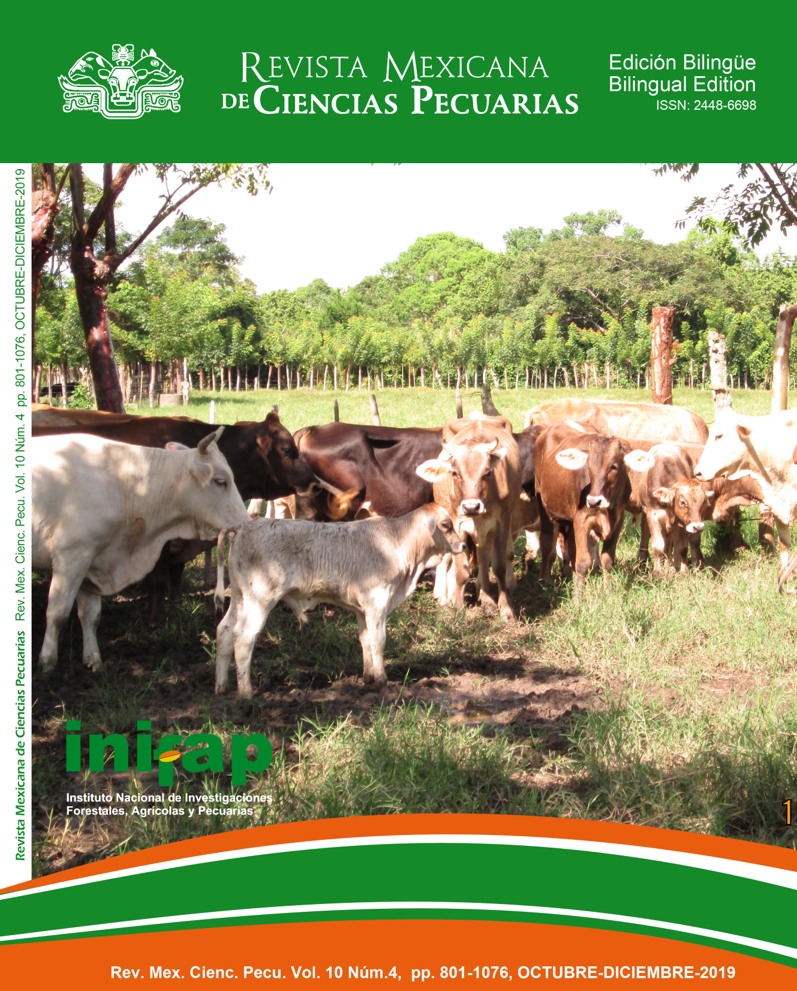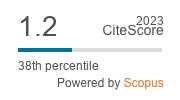Supplementation of ascorbic acid to improve fertility in dairy cattle. Review
DOI:
https://doi.org/10.22319/rmcp.v10i4.4703Palabras clave:
antioxidants, ascorbic acid, reproductionResumen
Ascorbic acid (vitamin C: VC) is an antioxidant that participates in the regulatory processes involved in the development of ovarian structures and fertility. However, supplementation of VC to dairy cattle to improve fertility has received little attention. However, reduced fertility in dairy cattle associated with high genetic merit for milk production and heat stress, which also diminish blood VC concentrations, suggest a potentially beneficial role for VC supplementation. The objectives of this review are to contribute to the current knowledge regarding the relationship between VC and fertility and to share many experiences that support the relevance of VC supplementation to improve dairy cattle reproductive performance.Descargas
Citas
Dobson H, Walker SL, Morris MJ, Routly JE, Smith RF. Why is it getting more difficult to successfully artificially inseminate dairy cows? Animal 2008;2:1104-1111.
Halliwell B, Whiteman M. Measuring reactive species and oxidative damage in vivo and in cell culture: how should you do it and what do the results mean? Brit J Pharmacol 2004;142:231-255.
Valko M, Leibfritz D, Moncol J, Cronin MT, Mazur M, Telser J. Free radicals and antioxidants in normal physiological functions and human disease. Int J Biochem Cell Biol 2007;39:44-84.
Rizzo A, Roscino MT, Binetti F, Sciorsci RL. Roles of reactive oxygen species in female reproduction. Reprod Domest Anim 2012;47:344-352.
Castillo C, Hernández J, López-Alonso M, Miranda M, Benedito JL. Values of plasma lipid hydroperoxides and total antioxidant status in healthy dairy cows: preliminary observations. Arch Tierz 2003;46: 227-233.
Gantner V, Bobic T, Gantner R, Gregic M, Kuterovac K, Novakovic J, Potocnik K. Differences in response to heat stress due to production level and breed of dairy cows. Int J Biometeorol 2017;1-11.
Bernabucci U, Ronchi B, Lacetera N, Nardone A. Markers of oxidative status in plasma and erythrocytes of transition dairy cows during hot season. J Dairy Sci 2002;85:2173-2179.
Takahashi M. Heat stress on reproductive function and fertility in mammals. Reprod Med Biol 2012;11:37-47.
Celi P, Merlo M, Da Dalt L, Stefani A, Barbato O, Gabai G. Relationship between late embryonic mortality and the increase in plasma advanced oxidized protein products (AOPP) in dairy cows. Reprod Fert Develop 2011; 23:527-533.
Luck MR, Jeyaseelan I, Scholes RA. Ascorbic acid and fertility. Biol Reprod 1995;52:262-266.
Ranjan R, Ranjan A, Dhaliwal GS, Patra RC. l-Ascorbic acid (vitamin C) supplementation to optimize health and reproduction in cattle. Vet Quart 2012;32:145-150.
NRC. National Research Council. Nutrient requirements of dairy cattle. 7th ed. Washington, DC, USA: National Academic Press; 2001.
Padilla L, Matsui T, Kamiya Y, Kamiya M, Tanaka M, Yano H. Heat stress decreases plasma vitamin C concentration in lactating cows. Livest 2006;101:300-304.
Joźwik A, Strzałkowska N, Bagnicka E, Grzybek W, Krzyżewski J, Poławska E, Kołataj A, Horbańczuk JO. 2012. Relationship between milk yield, stage of lactation, and some blood serum metabolic parameters of dairy cows. Czech J Anim Sci 2012;57:353-360.
Phillips PH, Lardy HA, Boyer PD, Werner GM. The relationship of ascorbic acid to reproduction in the cow. J Dairy Sci 1941;24:153-158.
González Maldonado J, Santos RR, De Lara RR, Ramírez GV. Impacts of vitamin C and E injections on ovarian structures and fertility in Holstein cows under heat stress conditions. Turk J Vet Anim Sci 2017;41:345-350.
Kramer MM, Harman MT, Brill AK. Disturbances of reproduction and ovarian changes in the guinea-pig in relation to vitamin C deficiency. Am J Physiol 1933 106:611-622.
Thomas FH, Leask R, Srsen V, Riley SC, Spears N, Telfer EE. Effect of ascorbic acid on health and morphology of bovine preantral follicles during long-term culture. Reproduction 2001;122:487-495.
Andrade ER, van den Hurk R, Lisboa LA, Hertel MF, Melo-Sterza FA, Moreno K, et al. Effects of ascorbic acid on in vitro culture of bovine preantral follicles. Zygote 2012;20:379-388.
Al-Katib SR, Al-Azam AHA, Habeab SA. The effect of vitamin C on ovary of female white rats treated with kmno4. Histological & physiological study. Kufa J Vet Med Sci 2012;3:1-16.
Gürgen SG, Erdoğan D, Elmas C, Kaplanoğlu GT, Ozer C. Chemoprotective effect of ascorbic acid, α-tocopherol, and selenium on cyclophosphamide-induced toxicity in the rat ovarium. Nutrition 2013;29:777-784.
Braw-Tal R, Yossefi S. Studies in vivo and in vitro on the initiation of follicle growth in the bovine ovary. J Reprod Fert 1997;109:165-171.
Machado-Pfeifer LF, de Souza-Leal SCB, Schneider A, Schmitt E, Nunes-Corrêa M. Effect of the ovulatory follicle diameter and progesterone concentration on the pregnancy rate of fixed-time inseminated lactating beef cows. Rev Bras Zootec 2012;41:1004-1008.
Rodgers RJ, Irving-Rodgers HF, van Wezel IL. Extracellular matrix in ovarian follicles. Mol Cell Endocrinol 2000;163:73-79.
Meur SK, Sanwal PC, Yadav MC. Acorbic acid in buffalo ovary in relation to oestrus cycle. Indian J Biochem Bio 1999;36:134-135.
Haliloglu S, Erdem H, Serpek B, Tekeli T, Bulut Z. The relationship among vitamin C, beta-carotene, vitamin A, progesterone and oestradiol 17-beta concentrations in plasma and cyst fluid of Holstein cows with ovarian cyst. Reprod Domest Anim 2008;43:573-577.
Pinnell SR. Regulation of collagen biosynthesis by ascorbic acid: a review. Yale J Biol Med 1985;58:553-559.
Rose UM, Hanssen RGJM, Kloosterboer HJ. Development and characterization of an in vitro ovulation model using mouse ovarian follicles. Biol Reprod 1999;61:503-511.
Murray AA, Molinek MD, Baker SJ, Kojima FN, Smith MF, Hillier SG, Spears N. Role of ascorbic acid in promoting follicle integrity and survival in intact mouse ovarian follicles in vitro. Reproduction 2001;121:89-96.
Paszkowski T, Clarke RN. The Graafian follicle is a site of L-ascorbate accumulation. J Assist Reprod Gen 1999;16:41-45.
Wu X, Iguchi T, Itoh N, Okamoto K, Takagi T, Tanaka K, NakanishI T. Ascorbic acid transported by sodium-dependent vitamin C transporter 2 stimulates steroidogenesis in human choriocarcinoma cells. Endocrinology 2008;149:73-83.
Serpek B, Baspinar N, Haliloglu S, Erdem H. The relationship between ascorbic acid, oestradiol 17β and progesterone in plasma and in ovaries during the sexual cycle in cattle. Rev Med Vet 2001;152:253-260.
Behrman HR, Preston SL, Aten RF, Rinaudo P, Zreik TG. Hormone induction of ascorbic acid transport in immature granulosa cells. Endocrinology 1996;137:4316-4321.
Guarnaccia MM, Takami M, Jones EE, Preston SL, Behrman HR. Luteinizing hormone depletes ascorbic acid in preovulatory follicles. Fertil Steril 2000;74:969-963.
Yacobi K, Tsafriri A, Gross A. Luteinizing hormone-induced caspase activation in rat preovulatory follicles is coupled to mitochondrial steroidogenesis. Endocrinology 2007;148:1717-1726.
Rodgers RJ, Irving-Rodgers HF, Russell DL. Extracellular matrix of the developing ovarian follicle. Reproduction 2003;126:415-424.
Murdoch WJ. Regulation of collagenolysis and cell death by plasmin within the formative stigma of preovulatory ovine follicles. J. Reprod Fertil 1998;113:331-336.
Khan FA, Das GK. Follicular fluid nitric oxide and ascorbic acid concentrations in relation to follicle size, functional status and stage of estrous cycle in buffalo. Anim Reprod Sci 2011;125:62-68.
Henmi H, Endo T, Kitajima Y, Manase K, Hata H, Kudo R. Effects of ascorbic acid supplementation on serum progesterone levels in patients with a luteal phase defect. Fertil Steril 2003;80:459-461.
Miszkiel G, Skarzynski D, Bogacki M, Kotwica J. Concentrations of catecholamines, ascorbic acid, progesterone and oxytocin in the corpora lutea of cyclic and pregnant cattle. Reprod Nutr Dev 1999;39:509-516.
Luck MR, Zhao Y. Identification and measurement of collagen in the bovine corpus luteum and its relationship with ascorbic acid and tissue development. J Reprod Fertil 1993;99:647-652.
Rapoport R, Sklan D, Wolfenson D, Shaham-Albalancy A, Hanukoglu I. Antioxidant capacity is correlated with steroidogenic status of the corpus luteum during the bovine estrous cycle. Biochim Biophys Acta 1998;1380:133-140.
Jaglan P, Das GK, Kumar BV, Kumar R, Khan FA, Meur SK. Cyclical changes in collagen concentration in relation to growth and development of buffalo corpus luteum. Vet Res Commun 2010;34:511-518.
Yassein SK, Mahmoud M, Maghraby N, Ezzo O. Hot climate effects and their amelioration on some productive and reproductive traits in rabbit does. World Rabbit Sci 2008;16:173-181.
Ullah I, Jalali S, Khan H, Shami SA, Kiyani MM. Effect of L-ascorbic acid on Nili Ravi buffalo oocytes during in vitro maturation. Pak J Biol Sci 2006;9:2369-2374.
Hossein MS, Kim YW, Park SM, Koo OJ, Hashem MA, Bhandari DP, et al. Antioxidant favors the developmental competence of porcine parthenogenotes by reducing reactive oxygen species. Asian Austal J Anim Sci 2007;20:334-339.
Wang X, Falcone T, Attaran M, Goldberg JM, Agarwal A, Sharma RK. Vitamin C and vitamin E supplementation reduce oxidative stress-induced embryo toxicity and improve the blastocyst development rate. Fertil Steril 2002;78:1272-1277.
Nadri B, Zeinoaldini S, Kohram H. Ascorbic acid effects on in vitro maturation of mouse oocyte with or without cumulus cell. Afr J Biotechnol 2009;8:5627-5631.
Seo MY, Lee SM. Protective effect of low dose of ascorbic acid on hepatobiliary function in hepatic ischemia/reperfusion in rats. J Hepatol 202;36:72-77.
Buettner GR, Jurkiewicz BA. Catalytic metals, ascorbate and free radicals: combinations to avoid. Radiat Res 996;45:532-541.
Carr A, Frei B. Does vitamin C act as a pro-oxidant under physiological conditions?. FASEB J 1999;13:1007-1024.
Chauhan SS, Celi P, Ponnampalam EN, Leury BJ, Liu F, Dunshea FR. Antioxidant dynamics in the live animal and implications for ruminant health and product (meat/milk) quality: role of vitamin E and selenium. Anim Reprod Sci 2015;54: 1525-1536.
Dalvit G, Llanes SP, Descalzo A, Insani M, Beconi M, Cetica P. Effect of alpha-tocopherol and ascorbic acid on bovine oocyte in vitro maturation. Reprod Domest Anim 2005;40:93-97.
Martin AJP, Moore T. Some effects of prolonged vitamin-E deficiency in the rat. J Hyg 1939;39:643-650.
Sivertsen T, Øvernes G, Østerås O, Nymoen U, Lunder T. Plasma vitamin E and blood selenium concentrations in Norwegian dairy cows: regional differences and relations to feeding and health. Acta Vet Scand 2005;46:177–191.
Saki G, Jasemi M, Sarkaki AR, Fathollahi A. Effect of administration of vitamins C and E on fertilization capacity of rats exposed to noise stress. Noise Health 2013;15:194-198.
Karanth S, Yu WH, Walczewska A, Mastronardi CA, McCann SM. Ascorbic acid stimulates gonadotropin release by autocrine action by means of NO. Proc Natl Acad Sci USA 2001;98:11783-11788.
Olson SE, Seidel GE Jr. Culture of in vitro-produced bovine embryos with vitamin e improves development in vitro and after transfer to recipients. Biol Reprod 2000;62:248-252.
Miclea I, Păcală N, Zăhan M, Hettig A, Roman I, Miclea V. Influence of alpha-tocopherol and ascorbic acid on swine oocyte viability and maturation. B. UASVM Anim Sci Biotechol 2011;68:338-345.
Tripathi A, Khatun S, Pandey AN, Mishra SK, Chaube R, Shrivastav TG, Chaube SK. Intracellular levels of hydrogen peroxide and nitric oxide in oocytes at various stages of meiotic cell cycle and apoptosis. Free Radical Res 2009;43:287-294.
Sales JN, Dias LM, Viveiros AT, Pereira MN, Souza JC. Embryo production and quality of Holstein heifers and cows with beta-carotene and tocopherol. Anim Reprod Sci 2008;106:77-89.
Descargas
Publicado
Cómo citar
-
Resumen1273
-
PDF 371
-
PDF445
-
Texto completo 134
Número
Sección
Licencia
Los autores/as que publiquen en la Revista Mexicana de Ciencias Pecuarias aceptan las siguientes condiciones:
De acuerdo con la legislación de derechos de autor, la Revista Mexicana de Ciencias Pecuarias reconoce y respeta el derecho moral de los autores/as, así como la titularidad del derecho patrimonial, el cual será cedido a la revista para su difusión en acceso abierto.

Esta obra está bajo una Licencia Creative Commons Atribución-NoComercial-CompartirIgual 4.0 Internacional.





